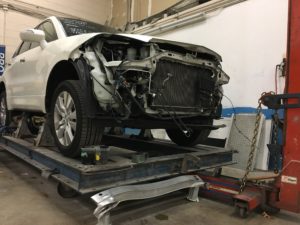Unless you hate your car and are looking for an excuse to buy a new one, most people fear that their vehicle will be declared a total loss after an accident. That’s the number one question we get asked.
The 70% Rule
And the fact is cars get totaled faster today than they used to for damages that may appear repairable even on a relatively new car with low miles. This is because most insurance companies have switched to a 70% rule where if the repair estimate is over 70% of the vehicle’s salvage value (the amount they think they can get for it by selling it to a junkyard) then the insurance company is going to total your vehicle and issue you a check.
And they have every right to do so because it is in your insurance agreement that you signed when you took out your car insurance policy.
But why 70%?
The truth is, nobody can write a 100% accurate estimate until your car is completely disassembled, and that includes machines. This means that panels are unbolted, the interior is out suspension removed, etc. around the affected area. All of these components can mask underlying structural issues that need to be replaced. In collision repair, this is called a supplement where the body shop will request an amount above that of the original estimate to cover the repair costs for hidden damages discovered during the repair.
Your initial estimate is merely a starting point to get the claim started. These supplements can sometimes cost more than the car is worth, so to prevent that, your insurance adjuster will determine what the value of the vehicle was before the accident (for replacement and value purposes), what the salvage value of the vehicle is (and will vary based on how old it is what condition it is in and how bad the damage is) and they will make a determination based on those amounts and the 70% rule.
Supplements can sometimes delay repairs because the body shop needs to estimate them, an adjuster needs to approve them, and additional parts and materials need to be ordered. This often comes at the cost of customer satisfaction, which is not good for the shop or the insurance company.
Why you may never see a field adjuster
Insurance companies have begun eliminating field adjusters in an effort to cut labor costs, and also because new Artificial Intelligence programs they have been developing are improving to a point mainstream use. Tractable is one such AI company who has been developing software to replace the field adjuster when handling a claim. But if you talk to a repair shop, they will all most likely tell you that a computer program viewing photos of damage can never replace the accuracy of a human being who is actually looking over the vehicle.
Tractable North American head Julie Kheyfets said Tractable artificial intelligence software can make salvage decisions while the customer is still on the first notice of loss call. She called it the “big breakthrough here.” The first notice of loss call is the moment you call your insurance company to inform them that your vehicle has been in an accident.
Without the AI technology, you would still have to wait for the vehicle to be towed to a shop, the shop to write a preliminary estimate, and the adjuster to view the vehicle and make a final determination on whether the vehicle is totaled or not. Now, this is all being handled on the first call.
According to Jimmy Spears, a longtime USAA veteran now serving as Tractable’s head of automotive, photo estimating and the first notice of loss are actually “two really separate events” — sometimes “days apart” for insurers today.
The New AI Photo Estimating Process
The traditional total loss process involves having an insurance representative asking the customer questions about variables like leaking fluid or drivability and using that checklist to total a car upfront. If the vehicle meets the checklist’s criteria, the insurer can flag it as a total loss with 95 percent accuracy according to Tractable.

However, this approach leaves insurers missing 70 percent of vehicles that the carrier also will eventually flag as a total loss, according to Tractable.
While the traditional process only captures 30 percent of total losses, Tractable’s AI catches between 80 to 90 percent of them, she said.
Its accuracy also might surpass the existing process, according to Kheyfets. Her company’s total loss calls are accurate 95-98 percent of the time, she estimated. “It’s very, very certain” the AI is right if it calls something a total loss, she said.
On the other hand, when an adjuster needs to view a vehicle to determine total loss, it may mean that the car has to be disassembled before the adjuster agrees that a car is a total loss. Most body shops can tell if a vehicle will total by looking it over and checking a few values in their estimating systems. Basically, it all comes down to how the insurance company deals with the information provided by Artificial Intelligence software.
So if your insurance company is using this photo estimating tool to begin your claim, there is a higher probability that the vehicle may get declared a total loss.


